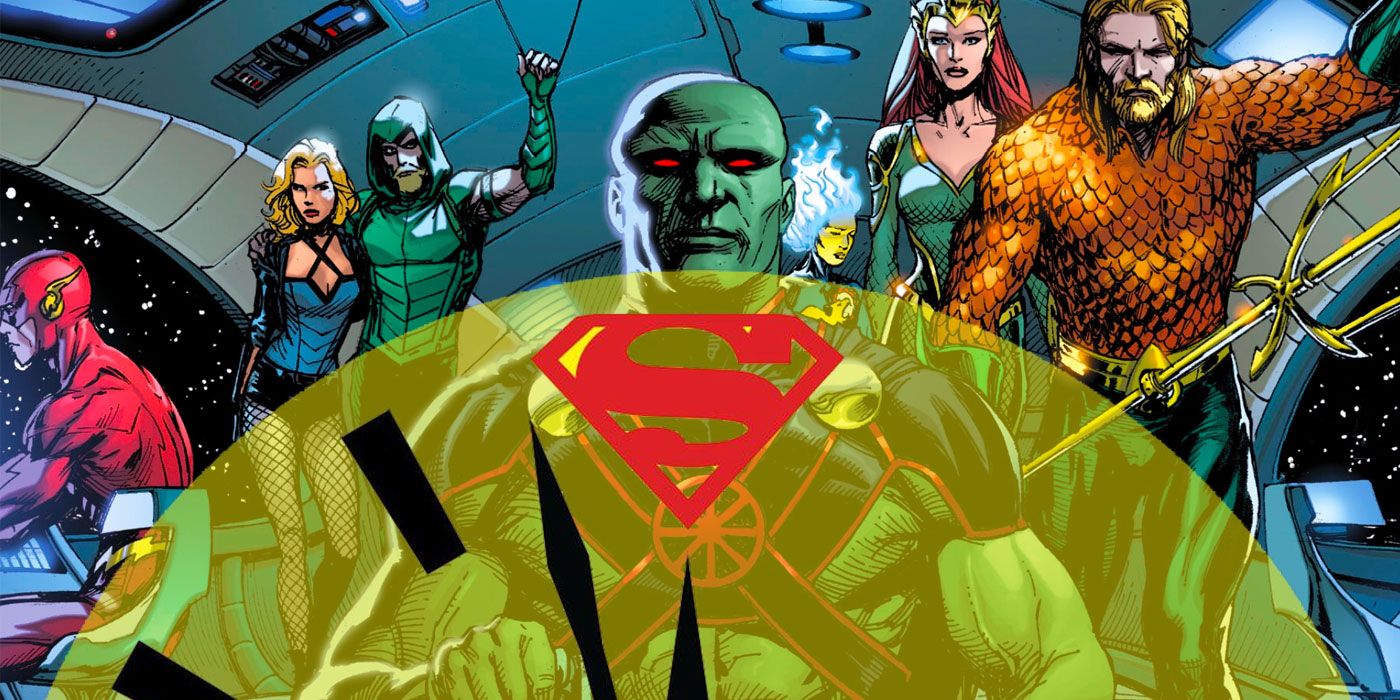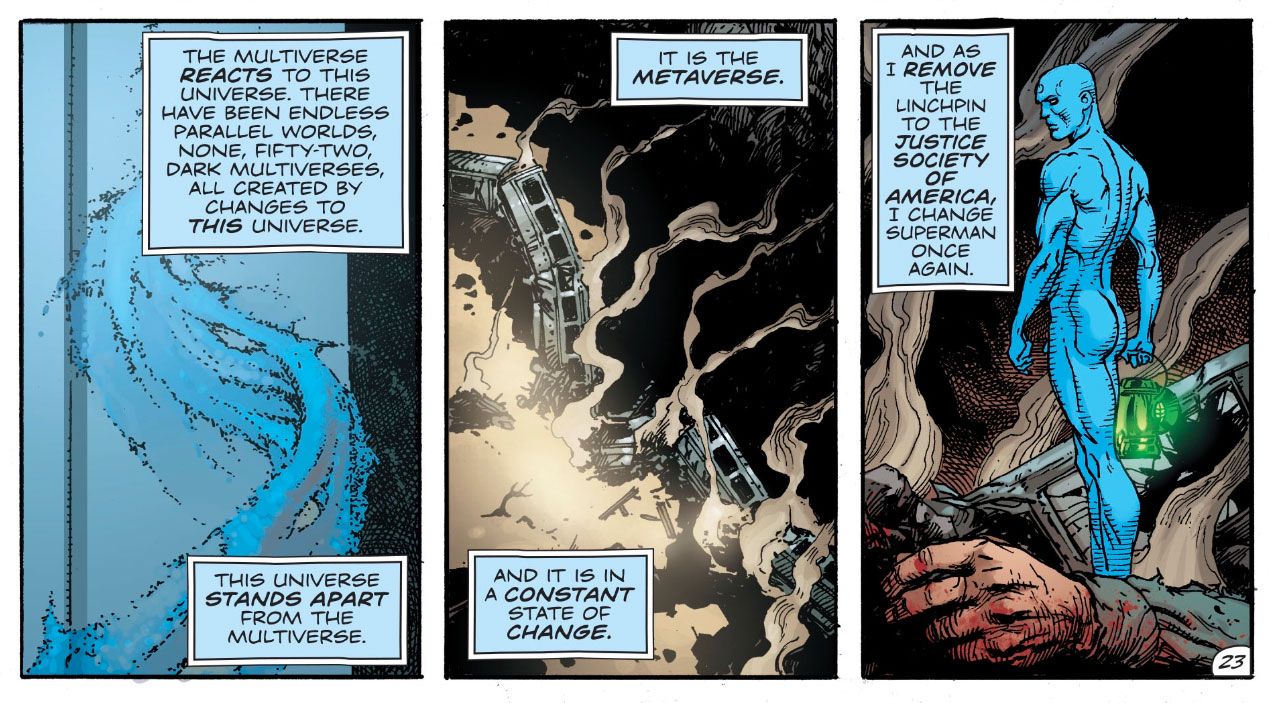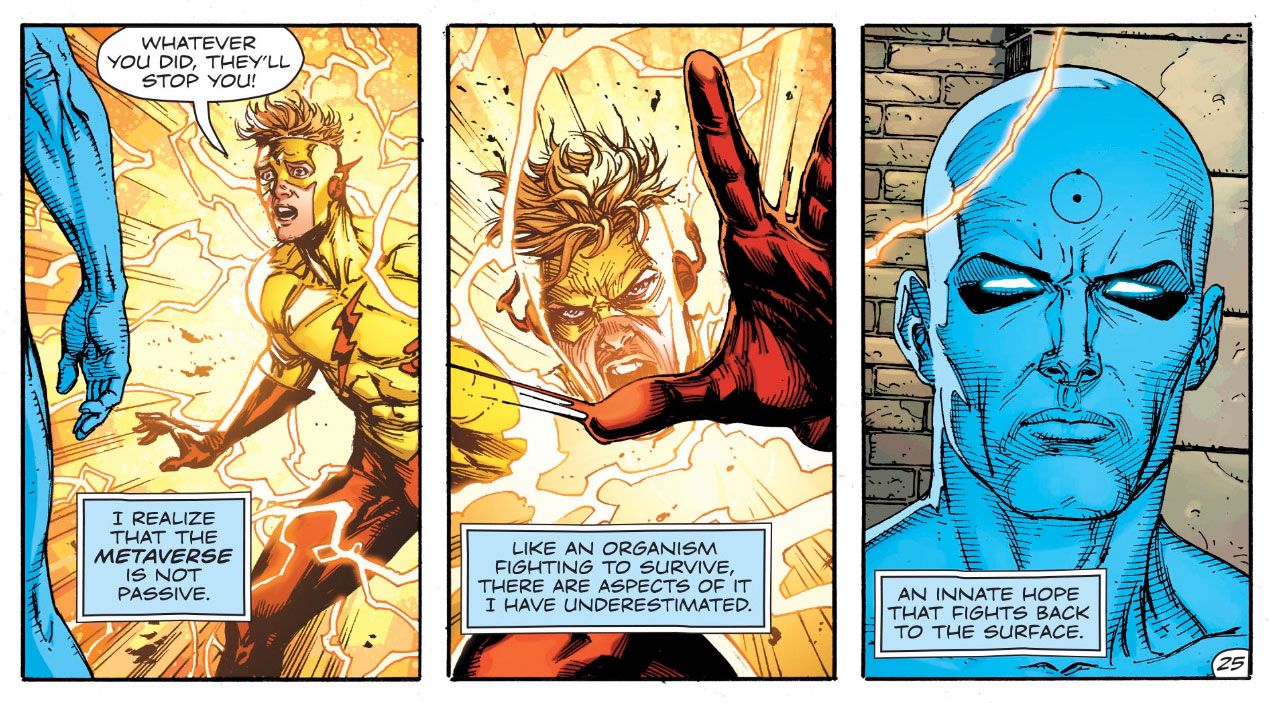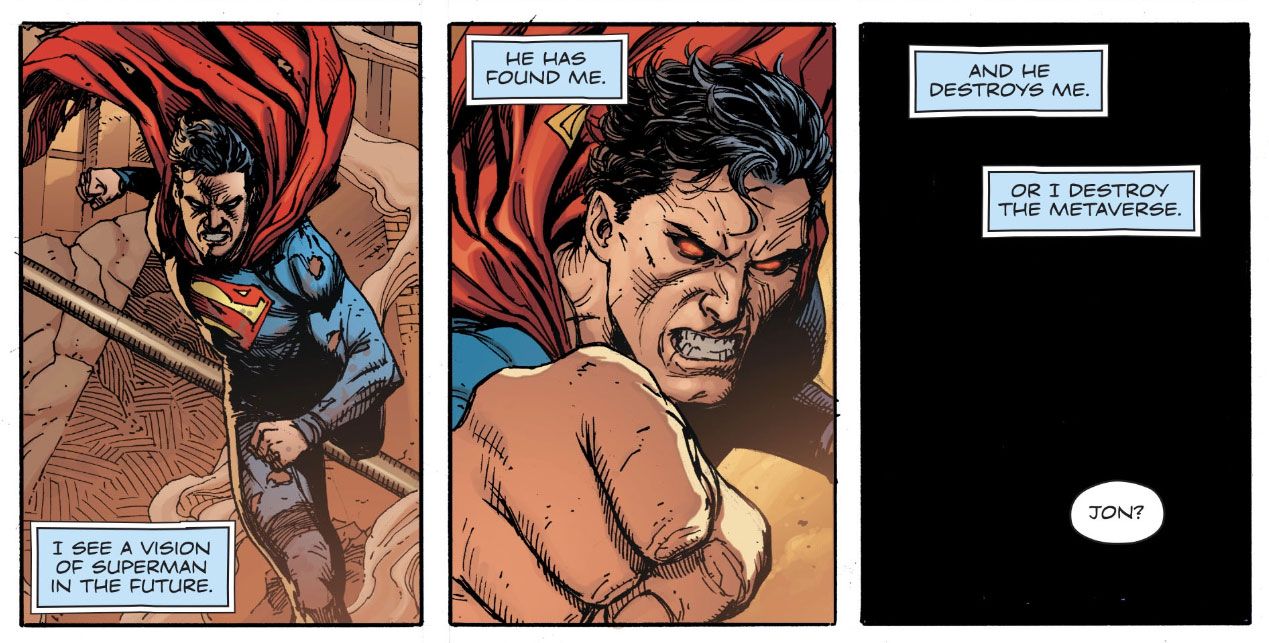SPOILER WARNING: The following article contains major spoilers for Doomsday Clock #10 by Geoff Johns and Gary Frank, on sale now.
The DC Multiverse has been rebooted many times over the past few decades. And the mainstream DC Universe -- currently known as Earth-0 -- has casually gone along for the ride throughout these multiple, continuity-altering crises.
At least, that's how it has seemed.
Geoff Johns and Gary Frank's Doomsday Clock #10, however, calls that fundamental notion into question. Earth-0 isn't merely another one of the many unique worlds populating the DC Multiverse, subject to the same rules as its alternate counterparts. It instead plays a far more pivotal role in shaping the multiverse around it.
And it's a revelation brought forth by none other than Doctor Manhattan, the all-powerful entity responsible for last reshaping the DCU.
Don't Call It the DC Universe Anymore
Manhattan's pending and long-awaited battle with the assembled heroes of the DCU is largely sidestepped by Big Blue himself. Incapacitating the heroes with ease, Manhattan then muses on not only his meddling with reality, but also past alterations seen in previous crisis-type events. More specifically, how these alterations impacted Superman, and the Man of Steel's own subsequent impact on the world, and universe, around him.
For instance, Manhattan acknowledges Superman's original first Golden Age appearance circa 1938, as well as his retconned first Silver Age appearance in 1956. Crisis on Infinite Earths is referenced as pushing the Man of Steel's first appearance forward another 30 years. Manhattan goes on to narrate his own modifications of DC history, which prevented the formation of the Justice Society of America, ushering in DC's "New 52" era. And the resulting alternations to Superman, leaving the character more detached from the very humanity he protects.
Reality allowed itself to be altered in past crises, but as Manhattan now reveals, reality this time is pushing back against Manhattan's machinations. The DC Universe doesn't want to be changed again, and it's fighting back. The return of Wally West was the first indication of its resiliency. The DC Universe isn't just another reality, a passive entity to be reshaped at the hands of whomever has the power to do so. No, it has the power to reshape itself -- and the multiverse around it.
Manhattan coins a new term for the DC Universe. Call it, instead, the DC Metaverse.
A Universe Like No Other
That's right, the universe of Earth-0 isn't just another reality like Earth-2, 3 or 10. This universe -- or metaverse -- doesn't react to changes to the multiverse. As Manhattan explains it, it's actually the other way around.
There is something special about the Earth-0 universe. Changes forced upon it drive further changes, rippling outward to the rest of the multiverse. Earth-0 is a kind of extradimensional ground zero, and perhaps the reason for its uniquely-assigned number. This particular universe stands apart from the rest, as Manhattan notes. It's an active participant in the definition, or redefinition, of the multiverse -- not merely a passive victim of any continuity-altering manipulations. At least, not anymore.
The term "metaverse" has been bandied about fandom with other higher-order terms like "megaverse" and "omniverse," implying a plane of existence beyond the multiverse. Manhattan's explanation, though, implies that the term doesn't exist beyond that of a normal universe, but instead alongside it. Just as in the world of the DCU there are countless normal humans, existing beside them are metahumans. Here, the "meta" concept is expanded and applied to an entire reality, not just its inhabitants.
And just as a metahuman has special powers, so does a metaverse. Might there be other "powered" universes, with the ability to influence reality, just as Earth-0 can? That's entirely possible, but even if that's so, the universe of Earth-0 is the first such metaverse.
Just as Superman is the first metahuman, and that might not be a coincidence.
Superman's Role in Shaping Reality
Manhattan has developed a seeming obsession with Superman's influence on the world around him. He acknowledges the Man of Steel as the first of the world's superheroes, despite also acknowledging that this isn't the case in all iterations of reality. In post-Crisis continuity, Superman was not the first superhero, but he still came into being. In the "New 52" reality, Superman likewise existed, albeit with a more distant persona.
No matter how reality is altered, and no matter who alters it, one constant has always remained: Superman, at some point, always comes into existence. Manhattan could stop Alan Scott from becoming the first Green Lantern, and even stop the JSA from forming as a result, but decades later, baby Kal-El still comes to Earth, and Superman is born later still.
Superman might not be "first" chronologically in all realities, but he nonetheless remains the first to inspire and impact the other heroes around him. He's the template for most every other superhero in existence. Without him, the world of superheroes would be very different, if it would even exist at all. The presence of Superman ripples outward around the globe -- just as the existence of Earth-0 ripples outward across the multiverse. One man, or metahuman, impacts all others, just as one universe, or metaverse, does the same.
If Superman has such influence on one world, and that world has influence on all others, then Superman is indirectly responsible for shaping the multiverse. There might even be a connection between Superman and the metaverse he occupies. And perhaps that is the answer to Manhattan's curiosity surrounding Superman's impact. And the postulation of an entirely different Superman Theory.
In the Final Analysis
Speaking of Superman, the Man of Steel was knocked out of action in Doomsday Clock #8, and awakens at the end of this issue in the immediate aftermath of Manhattan's metaversal revelation. Is this just a well-timed storytelling coincidence, or is there something more to Superman waking up at this exact moment?
Has Superman also somehow come to realize the significance of this reality, as well as his own overall importance? Did his encounter with Firestorm in Issue #8, who might have actually been Manhattan himself, based on that encounter's outcome, make him realize what Manhattan has done to reality? And might that be the cause of his rage against Manhattan, as seen in Doc's own final vision?
With two issues remaining, there are a lot of questions to be answered. Doomsday Clock #11 is scheduled to go on sale Aug. 14.




